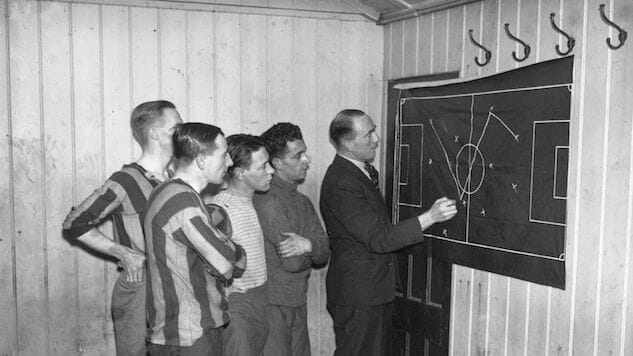The Trouble with Tactical Analysis
Photo by J.A. Hampton/Getty
When I first read that Pep Guardiola—Manchester City’s tactical wunderkind and football rock god to chalkboard fanatics the world round—believes formations like 4-2-3-1 and 4-4-2 etc are “meaningless,” “nothing but telephone numbers,” I was surprised at my sense of relief.
For years, I politely read “tactics pieces” and listened to TV pundits debate about how 3-5-2 “lines up” against 4-4-1-1, discussing in painstaking detail where the ‘overloads’ and ‘2 v1s’ and ‘3 v 2s’ would crop up to give one side an advantage over the other. All the while I suppressed the mental image of two managers standing astride a giant foosball table, furiously twisting and turning three bands of rigid, plastic players impaled along metal bars.
I long thought my skepticism of tactical analysis was the result of ignorance. Maybe I didn’t watch enough football, or I didn’t watch it the right way, or I didn’t watch enough live matches, or I didn’t read enough UEFA coaching manuals.
This wonderful world of Xs and Os and arrows seemed so convincing. Who was I to question it? Maybe what looked to me like faintly organized human chaos—the rapid moving in and out of space, the brief appearance and immediate dissipation of triangles, the surprise crossfield passes and mosh pit corner kicks—really could be understood simply by overlaying two patterns of unmoving dots like transparencies on an overhead projector and noting where the spaces appeared.
I don’t know exactly when the spell was broken, but it may have been shortly after the introduction of screencaps and gifs to the genre. Instead of colored dots on a white background with pitch lines, here we could see players in the flesh in the middle of an actual game, either in freeze frame or in ten second animations. Sometimes the authors added in helpful arrows and circles. These images/gifs were sandwiched between paragraphs describing some tactical pattern or another, a team or player’s “failure to close down,” or “failure to cover,” or a “gratuitous license to roam.”
Except it didn’t take long to discover that, unless the scope of the writer’s topic was limited to a single play in a single game, one could easily capture a gif or screenshot of the same club and the same group of players “revealing” precisely the opposite pattern to the one described. Maybe my own screencap or gif was the exception to the rule…but then how would one know unless one literally ‘added up’ these ever-changing instances and compared totals?
-

-

-

-

-

-

-

-

-

-

-

-

-

-

-

-

-

-

-

-

-

-

-

-

-

-

-

-

-

-

-

-

-

-

-

-

-

-

-

-








































